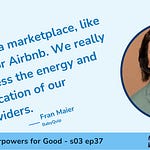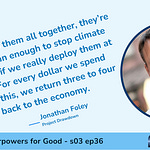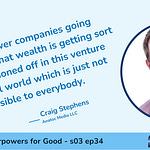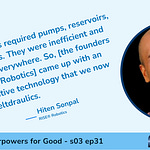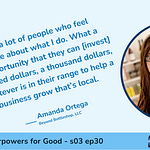Every month, I sit down with my friend and collaborator, Jen Risley, editor of Main Street Journal, for a live conversation about what’s working—and what’s next—in local investing and impact crowdfunding. These sessions keep me humble and energized. There’s simply more high-impact work happening than any one newsletter can cover, even when we publish more than once a day, and I’m grateful Jen brings her readers into this ongoing, practical conversation about building community wealth.
This month’s livestream circled three powerful themes:
How one statewide “buy local” champion became a policy and procurement force
Why small wind—done right—could be a missing piece in local clean-energy finance
What rural communities keep teaching us about ownership, scale, and “fair exchange” between local economies
Below I’ve stitched together the ideas in the most useful order I know: start with place, organize around ownership, and finance work that has a credible path to cash flow and measurable community benefit.
Scaling Local: The Kimber Lanning/Local First Arizona Playbook
If you want a concrete picture of what “going local” looks like at scale, study Local First Arizona and its leader, Kimber Lanning. In our discussion, I highlighted the organization’s growth to 65 staff and 2,500 paying members, and the way that capacity translates into actual power: influencing city procurement, training and mentoring entrepreneurs, and generally changing the rules of the game for locally owned businesses. That’s not a marketing campaign—that’s economic development.
From an investor’s standpoint, the lesson is straightforward: ecosystem capacity multiplies enterprise capacity. When cities rethink procurement, local firms land contracts. When founders get hands-on mentoring and peer accountability, they grow steadier revenue and become stronger candidates for Reg CF and community note offerings. This is the flywheel we want: policy → pipeline → performance.
A second takeaway is strategic humility. Not every community can—or should—copy and paste Arizona’s structure. Jen noted that the old “build a nonprofit business alliance” model was financially unsustainable in her small New Hampshire region, even though it succeeded in places like Phoenix. The right structure is local by definition. The goal is to right-size the vehicle so it can actually deliver value where you live.
Action moves for builders and funders:
Map the procurement levers you can move in the next 12 months (city, county, anchor institutions).
Stand up a founder services sprint (8–12 weeks) that teaches 5–10 local firms exactly how to win those contracts.
Pre-vet 2–3 entrepreneurs from that sprint for a Reg CF raise; pair with a local “buy from” campaign timed to their working-capital needs.
Small Wind, Big Idea: Cluster Effects & Localized Clean Energy
Jen brought a fresh perspective from my recent conversation with Dr. Daniel Farb of Flower Turbines. The concept that grabbed both of us: smaller wind turbines can improve each other’s performance when thoughtfully clustered—a “1+1>2” effect we don’t see with utility-scale wind. That’s a meaningful design distinction with financing implications.
Why does this matter? Because distributed wind complements rooftop solar in the two places where solar is weakest: at night and on cloudy days. That can reduce storage requirements—still costly and, in many chemistries, environmentally fraught. If we can meet more load in real time with a mixed portfolio (solar + small wind), we make community microgrids both cleaner and cheaper.
I also love the place-based finance angle. Flower Turbines’ current posture prioritizes local projects; if momentum builds, I expect a pattern we’ve seen with solar developers: batching geographically defined projects and raising for the bundle—streamlining diligence while preserving neighborhood-level benefits. That’s an ideal use case for impact notes and project-level Reg CF offerings with transparent revenue models (PPAs, leases, host-site savings shares).
Rural Reality Check: The Tupelo Model, Ownership, and Fair Exchange
Jen noted that her most-engaged post since we last met focused on rural communities going local—drawing on Michael Shuman’s reminder from the Tupelo model that without local ownership, “economic development” is often just transfer pricing on a map. If a town wins by luring a company from a neighbor, the region doesn’t grow; it just rearranges. Ownership, not attraction, is the engine.
This is where “impact crowdfunding” shines: it converts resident savings into resident equity and debt, keeping profits and control close to the people who live with the outcomes. Jen’s point lands because we still see candidates insisting the path forward is subsidizing outside firms to relocate—a habit that costs money and often steals jobs from another community rather than creating new value. There is another way.
We also revisited a beautiful nuance from the days of BALLE (Business Alliance for Local Living Economies): “fair exchange between local economies.” Being pro-local isn’t isolationism. It’s a commitment to buy locally first, then buy from another community’s local businesses when yours doesn’t produce the thing you need. That ethic builds inter-local solidarity instead of a zero-sum nationalism. It’s an attitude I’d love to see embedded in every regional procurement policy.
What We’re Building Together: Access + VIP Depth
A quick update on SuperCrowd25: yes, there were a couple small glitches, but the event delivered—eighteen hours of programming, every minute available free on the Superpowers for Good site. It’s embedded in a YouTube player, so you can speed it up, skip ahead, and go straight to highlights like Michael Shuman’s talk or Jen’s session. We’re also cutting individual clips and—because the SuperCrowdLA recap was a hit—planning a SuperCrowd25 book.
On the membership front, our operating philosophy is simple: publish most content free, then offer VIP depth that pays for the mission. We’re averaging 8–9 posts a week, with just one reserved for paying Impact Members. Our monthly webinars are open, and the VIP After-Call—including backstage Q&A with speakers at SuperCrowd25—offers that small-group, one-on-one access many of you value. Non-members can drop in for $25 when something catches your eye. That combo keeps the tent big and the lights on.
And because Main Street Journal is one of the most thoughtful voices in our space, I encouraged listeners to become paying subscribers there, too. Much of Jen’s most valuable work sits behind her paywall—for good reason. If you care about strengthening your town’s economic resilience, it’s worth it.
How These Threads Weave Together (and Why They Matter to Investors)
From where I sit, the three themes of this conversation converge on the same thesis:
Local First Arizona shows how ecosystem capacity (policy + procurement + services) turns into investable, revenue-generating opportunities for founders who live where their customers live.
Flower Turbines demonstrates that design choices (clustered small wind) can change the unit economics of clean energy at the site level—exactly where community investors can understand the business model and monitor outcomes.
The Tupelo model reminds us to finance ownership, not attraction. When residents own productive assets, we create compounding returns—financially and civically.
That’s impact crowdfunding’s sweet spot. We’re not speculating on abstractions; we’re backing understandable enterprises whose success visibly benefits our place. We ask founders to disclose risks and realities. We accept the discipline of regulated raises. We insist on alignment between mission, model, and metrics.
Keep the Conversation Going
You can watch every minute of SuperCrowd25’s programming for free, right now, and go straight to the segments that matter most to your work. We’ll keep pulling clips and assembling a book-length recap to make the content easier to use. And we’ll keep the tent wide—free content for all, depth for those who want VIP access.
If you value this conversation, support both communities: become a paying Impact Member here and a Main Street Journal subscriber there. That’s how we keep telling the stories that move capital, change policy, and grow ownership—on Main Street, where the impact shows up.
P.S. What did this month’s conversation spark for you? Reply with a note about a procurement shift you’re chasing, a clean-energy site you’re sketching, or a rural “shared services” idea you want to test. We’ll fold the best examples into upcoming posts—and, with your permission, into the SuperCrowd25 recap project we’re assembling now.






